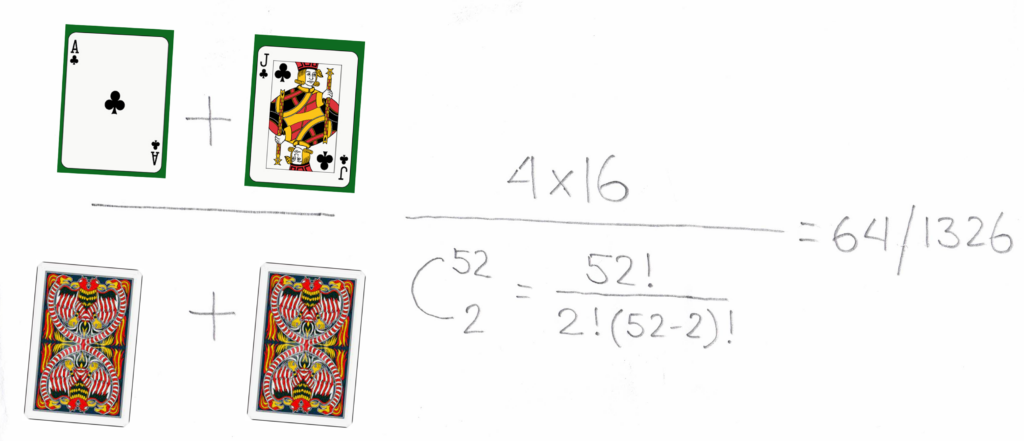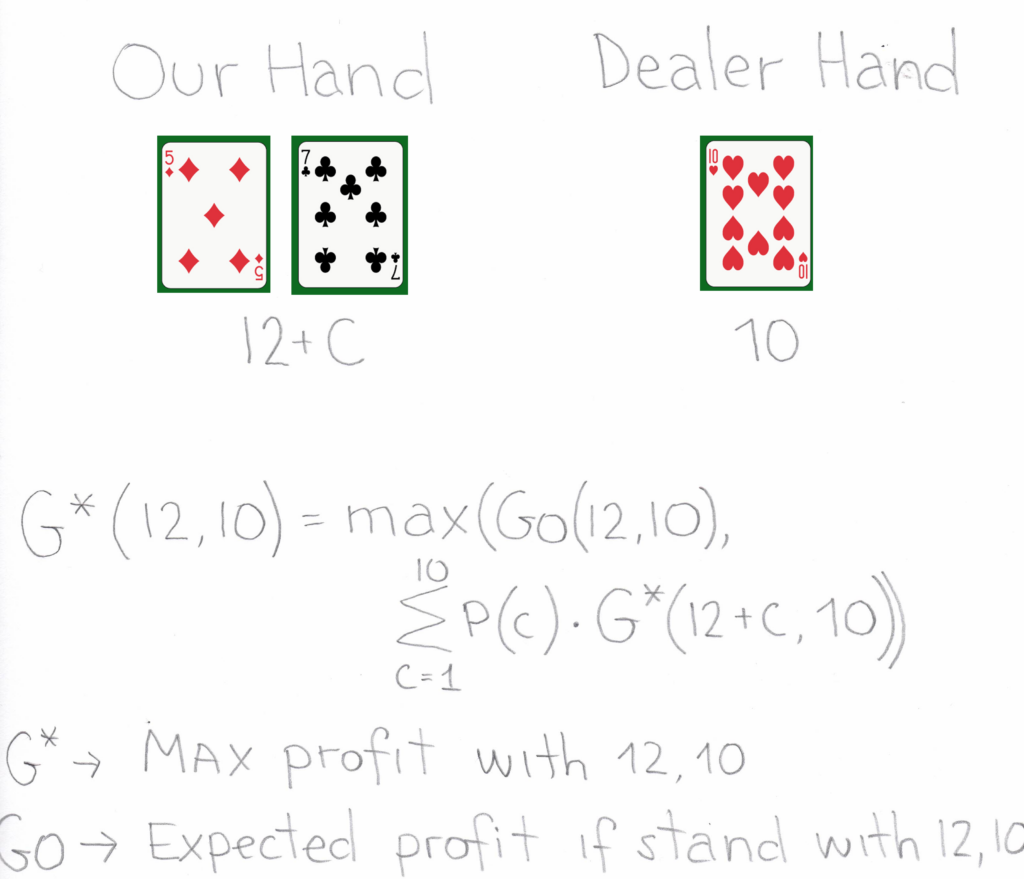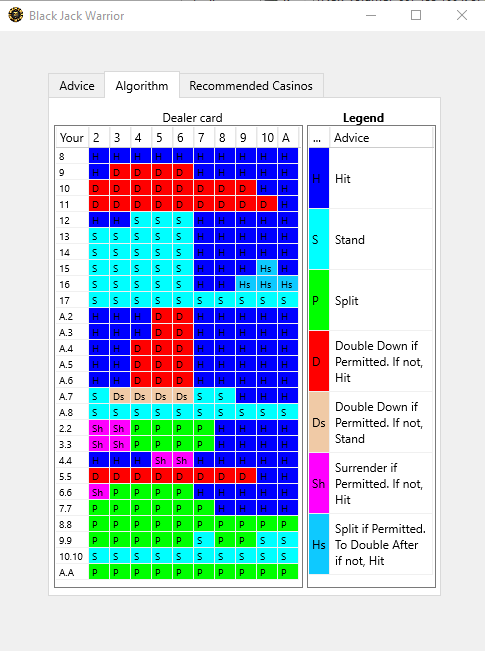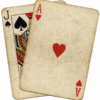Blackjack, a game of chance and skill, has captivated enthusiasts for centuries. While luck undoubtedly plays its part, strategic decisions hold the key to shifting the odds, albeit slightly, in the player’s favour. This article delves deep into the world of Blackjack, from the foundations of the Basic Strategy forged in the 1950s to the intricacies of the HI-LO card counting system. As we journey through the mathematical nuances, we’ll also explore the casino countermeasures designed to safeguard the house’s inherent advantage. Whether you’re a novice seeking to understand the game or an experienced player aiming to refine your strategy, this comprehensive guide offers valuable insights. Remember, the world of Blackjack is as much about the process as it is about the thrill of the game. Let’s deal you in!
Blackjack Moves
Taking a Card or Staying Put / Hit or Stand
One can opt to take a card to get their total closer to 21. However, one must be cautious. Should their capacity go over 21, they’ll lose the bet.
Doubling the Stake / Double down
For this move, your hand should add up to 9, 10, or 11 right at the game’s outset. You’ll be dealt just one more card when you decide to double your wager. Contrary to the American version of Blackjack, you can double on any hand.
Separating Cards / Split
If dealt two cards of the same number, you can divide them into two unique hands and play them concurrently. However, doing so necessitates placing an additional bet akin to the starting one. Remember, attaining 21 in a separate hand doesn’t equate to a blackjack. Some casinos offer the choice of doubling the bet on the newly formed hands after a split, which can benefit the player’s advantage. If this isn’t allowed, the odds tip more in the house’s favour by roughly 0.12%.
Safeguard Bet / Insurance betting.
If the dealer reveals an Ace, players can opt for an insurance bet, predicting the dealer might have a blackjack with their next card. They earn a reward if their prediction comes true after placing the bet.
Exiting the Game / Leave
In American Blackjack, players can exit, forfeiting only half their initial wager.
Blackjack Rewards
Winning against the house pays out at 1:1.
A Blackjack victory against the dealer rewards 3:2 provided there’s no draw. However, in Las Vegas American Blackjack, the payout is 6:5.
A Numerical Dive into Blackjack
Analyzing Blackjack necessitates understanding the card composition of a standard French deck, which comprises 52 cards:
- 4 Aces
- 16 cards valued at 10, including face cards.
- The rest, 32 cards, range from 2 to 9.
From this, one can deduce:
- Roughly a third of the deck comprises cards valued at 10.
- To secure a blackjack, one of the 4 Aces is essential. So, what are the odds?
The chances of landing a Blackjack can be determined by evaluating the combinations of achieving 21 with two cards against all two-card combinations from the deck. In simpler terms, it’s the ratio of favorable outcomes to all possible outcomes. This shouldn’t be mistaken for odds, even though they’re interlinked.
For a Blackjack, one requires an Ace and a 10. Given there are 4 Aces and 16 tens in the deck, the probability translates to: 4.16 / C(52,2) = 64/1326, which simplifies to a 4.8% likelihood of hitting a Blackjack.
Playing with multiple decks keeps the card proportions consistent. For instance, it’s equivalent to have 4 Aces in 52 cards as it is to have 8 in 104. However, the odds of drawing a specific card vary marginally since pulling one card from a 104-card deck impacts the game less than from a 52-card deck. Thus, each game variation demands its unique probability analysis.

Probability of Surpassing 21
To determine the likelihood of busting (going over 21), it’s crucial to assess the risk for every hand individually. For instance, if the value of our writing is 12.
When we decide to take an additional card:
Probability of Exceeding 21
12+AS=13
12+2=14
12+3=15
12+4=16
12+5=17
12+6=18
12+7=19
12+8=20
12+9=21
12+10=22
12+J=22
12+Q=22
12+K=22
4/13~30%
We discern that 4 out of the 13 possible outcomes result in going over 21. This translates to a 30% probability of busting when our hand value is 12. (This estimation is a broad view since the actual composition of the 12 could minutely influence the outcome. However, this approach is more precise and generally aligns with real-life scenarios.)
Probability of exceeding 21
21-100%
20 – 92%
19-85%
18-77%
17 -69%
16-62%
15-58%
14-56%
13-39%
12-31%
11 and less – 0%
A pattern emerges by executing similar evaluations for different hands: If the sum is 13 or higher, busting becomes typical for both the player and the dealer. Conversely, if the total is 11 or under, there’s no risk of busting with a single additional card; hence, the probability is 0%.
Dealer’s Risk of Exceeding 21
Consider taking another card if your hand’s value is under 14 is generally a good strategy. But what are our odds if we cap ourselves at 14?
2-35.3%
3-37.56%
4-40.28%
5-42.89%
6-42.08%
7-25.99%
8-23.86%
9-23.34%
10, J, Q, K – 21.43%
AS – 11.65%
Given that dealers typically continue drawing until they have 17 or more, standing with a value below 17 only works in your favour if the dealer busts. Otherwise, the dealer will have a hand equal to or more than 17, leading to a loss for players who stood with less.
Mathematically examining the dealer’s behaviour reveals the following tendencies:
For high-value cards, the risk of busting is relatively low, with the Ace granting the most benefits to the house. However, for low-value cards, although the risk is elevated, it always stays within the 50% mark.
On average, the dealer exceeds 21 around 28.35% of the time. This indicates that standing with a hand value less than 17 will result in a loss about 71.65% of the time.
Understanding the House Threshold
It becomes apparent that setting a personal limit below the dealer’s is disadvantageous, as it leads to frequent losses. However, observing the dealer’s exposed card provides insightful data for decision-making. This raises two queries:
- Why does the house set its limit at 17?
- What if a player mirrors the house’s strategy and also stands from 17?
The House’s Mathematical Edge
One must note that the dealer always plays after the player. If a player busts (goes over 21), they forfeit their bet regardless of the dealer’s subsequent actions. In scenarios where both the player and dealer bust, the house still wins since the player was eliminated first. This scenario plays out roughly 7.9% of the time, offering the house an 8% edge. Factoring in the 3 to 2 payout for blackjacks reduces this advantage to approximately 5.6%. This edge is a pivotal aspect of the casino’s advantage.
To counteract this, players are equipped with diverse strategies. They can double their bet, split hands, or fold. Most crucially, they have knowledge of one of the dealer’s cards, guiding their decisions beyond just hitting or standing. This knowledge reintroduces the role of mathematics in strategizing.
The Essence of Basic Strategy
During the 1950s, Roger Baldwin and his team of mathematicians pioneered the Basic Strategy. This approach aims to enhance player decisions to maximize long-term gains. It revolves around making the most profitable choice out of all available options, factoring in every possible scenario.
The strategy’s foundation is a probabilistic model. This model evaluates the player’s hand, juxtaposed against the dealer’s visible card. It dictates the most profitable choice whether to stand, hit, double down, split, or even take insurance. This holds true for both hard hands (those without an Ace) and soft hands (those with an Ace that can be counted as 1 or 11).

In mathematical terms, a recursive function, coupled with a comprehensive probability table for the dealer’s sum, establishes the expected gains. It weighs the potential gain from standing against the average potential gain from drawing another card. The outcome is a table highlighting the most mathematically sound action for any given card combination between the player and dealer. For those looking to master Blackjack, it’s advisable to familiarize oneself with this table.
One notable point is that the table suggests standing for hard hands valued at 17 or more. This implies that no matter the dealer’s card, the expected return is maximized by choosing to stand. This insight sheds light on why the house opts for a threshold of 17, treating the house as another player in the game. Furthermore, taking insurance is generally discouraged. Even when the dealer has an Ace, landing a Blackjack is far from guaranteed.
This strategy trims down the house’s edge from 5.6% to less than 1%. However, the actual percentage can shift based on table rules and the number of decks in play. While it’s touted as the ‘optimal’ approach, it doesn’t guarantee consistent wins. The strategy still operates under a small disadvantage. This is largely because high cards from the dealer adversely affect our advantage more than their low-value counterparts. Thus, even when making the best decisions, victory isn’t assured, but you increase your chances significantly.

The odds differ slightly in the American Blackjack version but never climb above 1%, provided one adheres to the basic strategy tailored for the specific game variant. It’s crucial to remember that each game type demands its distinct strategy. Learn more about Blackjack strategy charts
Dissecting the Basic Strategy
If the premier strategy merely curtails losses, is it truly feasible to secure consistent wins in blackjack?
To tackle this inquiry, we must grasp the foundational assumptions of this approach. The Basic Strategy operates under the premise that card odds remain static throughout the game. This assumes that the likelihood of drawing an Ace, number, or face card remains unchanged. Yet, this isn’t entirely accurate, as card odds fluctuate as hands are dealt.
What if there was a method to track these cards, leading to more victories?
Mastering Card Counting: The HI-LO System
Introduced in 1962 by a mathematician and former IBM employee in the groundbreaking book “Beat the Dealer,” the HI-LO system offers a systematic approach to the game of Blackjack. The core concept revolves around tracking high cards, which are essential for forming a blackjack. By understanding how many high cards have been dealt, one can gauge the likelihood of upcoming high cards, granting a tangible edge.
Memorizing every card dealt might seem daunting, but thanks to the elegance of math, the HI-LO system simplifies it. Cards are tagged with three values: -1, 0, or 1. High cards carry a -1, low cards a +1, and the middle cards a neutral 0. Players keep a running tally as the game progresses, considering all cards, including the dealer’s.
Given the balanced high to low cards ratio, a positive or negative count directly indicates the proportion of high cards left. A negative count implies a surplus of high cards have been dealt, reducing our chances, whereas a positive count suggests more high cards are imminent, presenting an opportunity.
The ultimate goal is amassing a significantly positive count, signaling higher blackjack probabilities. At this “hot table” moment, players can adapt their basic strategy, perhaps by increasing their bets. Because Blackjack offers a 3 to 2 payout and ties are infrequent, this system offers a genuine opportunity to tilt the odds against the house— all thanks to the beauty of math.
Interestingly, the culmination of all card counts after a full deal must be zero. This stems from the equilibrium of five high and five low cards. However, given there are more numerical cards than aces and tens, three remain neutrally valued to maintain balance.
For multi-deck games, players must adjust. The same count carries different implications with four decks remaining versus just one. Players should divide their current count by the estimated decks remaining to ascertain the true count.
While the HI-LO system is foundational, other counting methods, albeit more intricate, offer improved efficiency. Grasping HI-LO, however, sets the foundation for mastering these advanced techniques.
Despite this system’s edge, it’s vital to note that its advantages manifest over thousands of hands, yielding fractional percentage gains. It necessitates deep pockets and immense patience. Learn more about Blackjack HI-LO Strategy
Countermeasures Against Card Counting
Casinos, naturally, have devised strategies against card counters:
- Increasing Decks: More decks complicate card counting. With increasing decks, the variance in card count decreases, making it tougher to predict outcomes.
- One Deck: 0.17%
- Two Decks: 0.46%
- Four Decks: 0.60%
- Six Decks: 0.64%
- Eight Decks: 0.66%
- Shuffling Techniques: Modern casinos employ mixers and automatic shufflers mid-game, resetting any accumulated counts and neutralizing the counter’s advantage.
- Rule Alterations: Some establishments, like those in Las Vegas, have tweaked Blackjack payouts to 6 to 5, amplifying the house’s edge. If counters are suspected, casinos might even adjust betting limits.
Though card counting is lawful, being identified as a counter can lead to expulsion. Given casinos’ expertise, consistently winning big raises red flags.
Final Thoughts
While mathematics does indicate potential Blackjack wins, consistently profiting is neither simple, swift, nor economical. For aspiring players:
Master and customize the basic strategy.
Avoid tables offering less than a 3 to 2 payout.
Opt for tables with fewer decks and be well-versed in table rules.
If card counting, scrutinize shuffling techniques and test your methods before committing sizable funds.
Remember:
More decks favor the house.
Unfavorable rules boost the house’s chances.
Lack of strategy or insight? The house wins faster and more often.
Does the house always win? Not invariably, but when it doesn’t, rest assured it’s continually refining its strategy. After all, casinos are businesses at heart.








